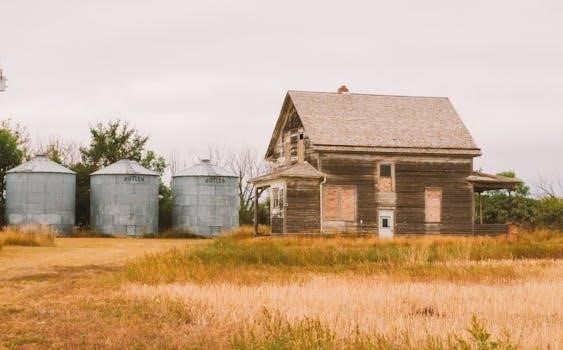Parable of the Sower⁚ An Overview
Octavia Butler’s Parable of the Sower, published in 1993, is a dystopian science fiction novel set in a collapsing United States․ It follows Lauren Olamina’s journey as she develops a new religion amid societal breakdown․
Publication and Setting
Parable of the Sower was published in 1993, marking a significant contribution to the science fiction genre․ The novel’s narrative unfolds through diary entries penned by the protagonist, Lauren Olamina, between the years 2024 and 2027․ The setting is a post-apocalyptic California, specifically in the area surrounding Los Angeles․ Society has crumbled due to environmental disasters, social inequality, and corporate greed, creating a bleak and dangerous landscape․ The story is set against the backdrop of a decaying United States where walled communities offer fragile protection against widespread violence and chaos․ This dystopian world serves as a stark warning about the consequences of societal negligence․
Plot Summary
The novel tells the story of Lauren Olamina, a young woman with hyperempathy, living in a walled community near Los Angeles․ As society collapses around them, Lauren develops a new belief system called Earthseed, which emphasizes change and adaptability․ When her community is destroyed, she and a small group of survivors embark on a perilous journey north, seeking safety and a new beginning․ Throughout the journey, they face numerous dangers, including violent raiders, and internal conflicts․ Lauren’s leadership is tested as she guides her followers towards a new way of life, based on her Earthseed philosophy․ The plot explores themes of survival, community, and the human condition․

Key Characters
The narrative centers on Lauren Olamina, the protagonist, and also includes her father, Reverend Olamina․ Additionally, key characters like Harry Balter and Zahra Moss play vital roles․
Lauren Olamina
Lauren Olamina is the central figure of the novel, a young Black woman possessing hyperempathy, which allows her to feel others’ pain․ This condition shapes her worldview and fuels her creation of Earthseed․ She is intelligent, strong-willed, and visionary, defying stereotypes as she navigates a brutal post-apocalyptic world․ Lauren’s leadership skills are continuously tested as she strives to protect her followers․ She grapples with morality and identity as she seeks to establish a new community based on her Earthseed principles, making her a truly compelling and complex character․ Her diary entries reveal her inner struggles and growth, making her deeply relatable․
Reverend Olamina
Reverend Olamina is Lauren’s father, a Baptist minister, and a figure of traditional authority․ He represents the established order and often clashes with Lauren’s progressive ideas and beliefs․ He is a stern and somewhat rigid character, deeply rooted in conventional religious practices․ Despite his disapproval of Lauren’s visionary thinking, he exhibits a protective paternal love for his daughter․ His inability to comprehend or accept her Earthseed philosophy highlights a generation gap and the limitations of traditional belief systems in a changing world․ His tragic death underscores the vulnerability of even the most established figures in the face of societal collapse, marking a critical turning point in Lauren’s journey․
Central Themes
Parable of the Sower explores community survival, change, and adaptability amidst societal collapse․ The novel also delves into the complexities of religion, spirituality, and the human condition in a chaotic world․
Community and Survival
The novel emphasizes the critical role of community for survival in a post-apocalyptic world․ Lauren Olamina’s Earthseed religion highlights the importance of working together and building a supportive community to navigate the harsh realities of their environment․ The characters face constant challenges, including violence, poverty, and environmental disasters, and their collective efforts are vital to their continued existence․ The story underscores how essential cooperation and mutual support are for overcoming adversity and creating resilience in the face of a collapsing society․ Through Earthseed, the novel advocates for a future where community is the foundation of survival․
Change and Adaptability
Parable of the Sower strongly emphasizes the necessity of change and adaptability for survival in a constantly shifting world․ Lauren Olamina’s Earthseed philosophy centers on accepting and embracing change as a fundamental aspect of existence․ The novel portrays a world in perpetual flux, where characters must constantly adjust to new challenges and circumstances․ The ability to adapt to new situations is presented as a vital skill for survival, both for individuals and communities․ Lauren’s own journey is a testament to the importance of flexibility and the willingness to modify one’s beliefs in the face of new realities․

Thematic Elements
The novel explores a post-apocalyptic world marked by societal collapse, environmental devastation, and rampant violence․ These elements highlight the fragility of civilization and the struggle for survival․
Post-Apocalyptic World
Set in a dystopian future, Parable of the Sower portrays a United States ravaged by climate change, social inequality, and economic collapse․ The novel depicts a landscape of rampant violence, poverty, and lawlessness, where communities are walled off for protection and resources are scarce․ This bleak environment reflects the breakdown of societal structures and the fragility of civilization․ The post-apocalyptic world is not just a backdrop; it is a character in itself, shaping the choices and actions of the characters, forcing them to adapt and struggle for survival amidst chaos and despair․ It serves as a chilling reminder of the potential consequences of neglecting social and environmental issues․

Literary Style and Structure
The novel employs a diary format, narrated by Lauren Olamina․ Butler’s writing is clear and precise, using simple language to convey complex themes․ The structure is chronological, marked by dated entries․
Narrative and Language
Butler’s narrative style in Parable of the Sower is characterized by its directness and immediacy, primarily due to the diary format through which the story unfolds․ The language is accessible and unembellished, reflecting the practical and survival-oriented mindset of the protagonist, Lauren Olamina․ The use of first-person perspective immerses the reader in Lauren’s thoughts and experiences, fostering a deep connection with her struggle․ The narrative voice is compelling, marked by a blend of vulnerability and resilience, as Lauren grapples with the horrors of her post-apocalyptic world and her own emerging faith․ This combination of simple yet powerful prose allows the reader to fully engage with the story’s themes and emotional depth․

Critical Reception
Parable of the Sower has garnered significant acclaim for its powerful themes, realistic portrayal of a dystopian world, and thought-provoking exploration of social issues․ It is considered a groundbreaking work․
Acclaim and Recognition
Parable of the Sower has received widespread critical acclaim since its 1993 publication, lauded for its compelling narrative and insightful exploration of pertinent societal issues․ The novel has been recognized as a groundbreaking work of science fiction, praised for its realistic portrayal of a dystopian future and its complex characters․ It has won awards, such as the Nebula Award for Best Novel, solidifying its place as a significant work in the genre․ Critics have celebrated Butler’s clear and precise language, as well as the novel’s thought-provoking themes, making it a must-read for those interested in the intersection of social problems and the human experience․ Its impact is further underscored by its adaptation into a graphic novel and an opera, attesting to its enduring relevance and cultural significance․
